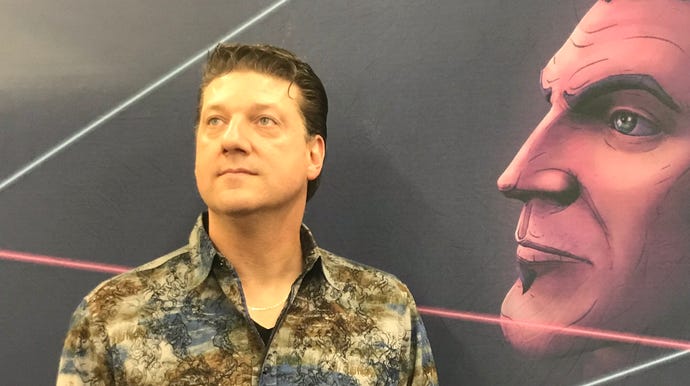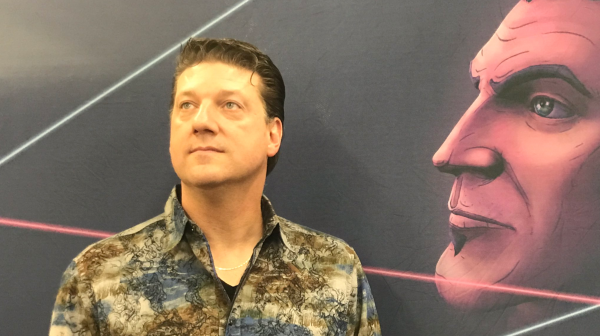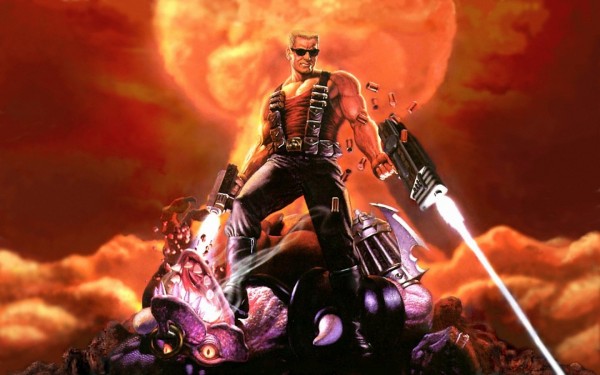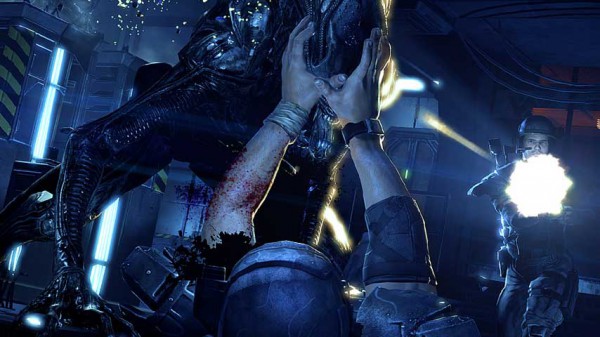Best of 2018: Clowns, Houdini, and a vanishing teenager - the Borderlands developer isn't your regular video game studio
It’s been a wild year for VG247, so to celebrate we’re going to be republishing some of our favourite work published in 2018 – opinion pieces, features, and interviews, that we’ve enjoyed writing and reading, and which we believe showcase some of our best work. Enjoy!
Clowns, Houdini, and a vanishing teenager – the Borderlands developer isn’t your regular video game studio was first published on October 11, 2018.
Randy Pitchford is making his teenage son disappear.
I’ve been invited to a night at The Peacock, an event the Gearbox Software founder puts on at his massive house in a gated community somewhere in Texas.
So far, I’ve seen sad clowns twirl chrome spheres and dance with a length of cloth. I’ve explored secret rooms. I’ve seen sleight of hand magic performed inches from my face. A man has juggled eight basketballs, a glass jug has levitated and poured itself a cup of water, and now Pitchford is locking his kid inside a dematerialisation chamber. I have had zero drugs.
Sure enough, Pitchford Jr. turns transparent and fades away.
The dematerialisation chamber is an impressive visual trick designed by Jim Steinmeyer, the creator of the vanishing Statue of Liberty illusion, performed by David Copperfield. Randy Pitchford has one in his house. As you do.
If you didn’t know he was behind the studio that creates the Borderlands series, you would swear Pitchford was solely a magician and entertainer. All around his house there are huge tomes on magic. Even the way the home is built - every inch of it to Pitchford’s specifications - encourages exploration, full of secret compartments and hidden rooms: a clue to his video game experience, perhaps. At one point, Pitchford himself takes to the stage and performs some mentalism, in which he has dedicated the first 10,000 digits of the number pi to memory.
Magic is the night’s theme - it’s in every inch of the architecture of this huge home, and it even runs in Pitchford’s blood.
You see, Pitchford’s great uncle is Richard Valentine Pitchford, a prominent magician in the early 1900s who went by the stage name Cardini. Cardini was so influential that there is an exhibit dedicated to him at the Magic Castle in Hollywood. “All the props on display in the exhibit are artefacts that my wife and I left to the Academy of Magical Arts for the museum display,” Pitchford tells me. Pitchford himself is also a prominent member of the organisation.
Recently, Pitchford and his wife, Kristy, were at a pyjama party with the Magic Castle’s founder, Milt Larson, in Santa Barbara. Milt Larson’s wife, Arlene, decides she wants to turn Kristy Pitchford into a queen, so she pops a bejewelled tiara on her head and drapes a brooch around her neck. “After all this goes down, Arlene explains that, ‘that broach that I put around your neck, it once belonged to Bess Houdini’,” Pitchford remembers.
“The story is, that brooch was given to the Houdinis by the Tsar of Russia, Nicholas the II, when he invited them to Moscow in the hopes to recruit Harry Houdini to be his mystical advisor. Harry Houdini didn’t take the job, the job was taken by Rasputin, and we know how that turns out.”
A while after the party, the Larsons put the brooch up for auction to raise money for a Magic Castle cabaret in Santa Barbara, but Pitchford can’t make it to the auction. The piece is estimated to reach $30,000, so he puts in a proxy bid for $55,000. The brooch goes for $60,000. The buyer? David Copperfield.
“So David calls me a few months later, because a magician had posted a story on the Academy of Magical Arts Facebook page linking to an article about Bess Houdini,” Pitchford explains. “In the article she talked about her visit to Moscow, but the dates she mentioned were discrepant with what historians know. So, what if the whole Nicholas the II story, and the Tsar of Russia, was bullshit? These are the Houdinis, great self promoters. What if this was a story invented?”
Pitchford didn’t care if the story was fabricated, though. He cared that it belonged to the Houdinis and made his wife happy. Copperfield said he could have it for his buying price: $72,000, with fees. “He’s like, can you bring cash?,” Pitchford laughs. “I’m about to get on a flight to Vegas because I’m working with Penn and Teller on a VR project – Penn and Teller’s VR: Frankly Unfair Unkind, Underhanded and Unnecessary. it’s effectively a collection of VR magic tricks.
“It’s February 11, I’ll pick up the brooch and give it to my wife on Valentine’s Day. I have a briefcase loaded with $72,000, and because of the timing of the day, I don't have time to drop it off at a safe. I'm going to the P&T theatre, and the security guy needs to see inside the case. Incidentally, there was another magician with me, whose stage name is actually Handsome Jack. His name predates Handsome Jack the video game character. He’s just laughing his arse off because he knows what’s in the briefcase. So I open the case and the security guard reacts like Marcellus Wallace opening his briefcase in Pulp Fiction.”
Just a normal day in the life of a triple-A studio head.
Pitchford’s love of video games and magic didn’t happen separately. Rather, he immersed himself in both worlds concurrently, tinkering with programming on some days and putting on magic shows on others. “Professionally, the first time I was paid to perform magic predates the first time I was paid to make video games, Pitchford says. “I think I got more serious about games ahead of when I got serious about magic. I got serious about magic in my late teens and serious about games in high school, as a programmer.”
That first job in magic came when Pitchford sauntered up to a magic club that was about to open and asked for a job. The owner asked him to show him some tricks, so he did and they were impressed. “You got a tuxedo, kid?” the owner asked. “Yup,” Pitchford lied. “Great, you’re hired.” It was essentially a bar job where the bartenders performed close magic for the punters, as well as the occasional stage show for the dinner theatre, but that gig led to more work and the odd show at the Magic Castle.
As for video games, aside from mailing stuff to AOL and Compuserve and asking for donations, Pitchford’s first proper gig in games was at Duke Nukem developer 3D Realms. Serendipitously, it turned out that experience with magic was also useful when creating a video game.
“They’re identical. They're entertainment. They are bullshit,” Pitchford says. “The pitch is, ‘hey I’m gonna show you something that isn't real, but if you come with me, if you follow my rules, I’m gonna give you a payoff’.”
Essentially, both ask the same thing from their audiences: suspend your disbelief and experience a world where anything is possible. You can see why a magician would be enamoured by digital illusions, where sleight of hand and distraction techniques have names like ‘frustum culling’ - in fact, that sounds a bit like a Harry Potter incantation.
Still, whatever Pitchford is doing, you can tell he feels more comfortable doing it in front of an audience - whether they are sat holding a controller, or perched on one of the chairs in his home theatre.
During my night at The Peacock, Pitchford is never alone. He’s always at the head of a group with people around him. Everyone else is listening as he tells them stories. He’s the host of the party, sure, but it seems like he is most comfortable when putting on a performance.
“I’m actually an introvert,” Pitchford says, when asked if magic helped his confidence. “I spend a lot of energy when I'm ‘on’, so to speak, when I’m with other people. A lot of folks that may have met me or seen me in social environments might say I’m an extrovert, but I’m actually quite shy. My favourite thing to do when im not creating entertainment are usually solo experiences - playing video games, practicing magic, or watching movies.
“I’m not a naturally social creature, but magic helped me develop some skill in interacting with other people. Particularly close up magic - it helped me develop comfort in approaching strangers, or developing some kind of ability to relate to people that I've never met before. And that’s helpful in my job - Gearbox has been in a steady growth rate since we were created 20 years ago, so there are always new people joining. And I have to find a way to relate to them, and give them the opportunity to relate to me.”
Currently, Gearbox is working on multiple projects. Pitchford says he’s still directly involved in some of them, despite being the company’s president. He started out in the video games industry as a level designer working on Duke Nukem and Shadow Warrior, and he still tinkers with level design, production, directing, and writing at his company.
“When I left 3D Realms I joined this guy and his brother – genius programmers and software engineers – and they founded this company,” Pitchford remembers. “It was an egalitarian concept where everybody was equal. I learned a lot about what not to do when I was at 3D Realms, and I also learned a lot about what not to do at the successor, Rebel Boat Rocker. But I also learned the power of a team that was committed to one another, and could anticipate each other, working towards a shared vision. Our project was cancelled by EA - we shut down and we all looked around.
“I probably interviewed with 25 different game developers and many of them lead to offers. They were interviewing me, but I was also interviewing them, and I don't know how to say this without sounding cocky or condescending, but the feeling I had back then - and this was a younger version of myself - was: ‘these people all have clown shoes on, I think we’re better off trying again on our own’. A whole bunch of them don't exist anymore, so maybe I was right.”
Gearbox has now been around for 20 years. The studio has had some high profile successes with games such as Borderlands, its sequels and spinoffs. It’s also had some failures with games such as Battleborn and Alien: Colonial Marines. But the studio has survived everything that’s been thrown at it because it grew at a slow and steady pace, rather than staffing up too quickly and taking on too much.
“Rebel Boat Rocker took every risk,” Pitchford remembers. “[They] wanted to write their own engine, we were creating an IP, and creating a company. All of those take time and energy. So when we started Gearbox, the first thought I had was, ‘let’s minimise the number of problems we have, let’s take them one at a time’.”
The initial focus was on the company. Why take risks and build your own IP and engines when there are engines you can use and IPs you can work on? And so, Gearbox began work on Half-Life: Opposing Force, an expansion pack for Valve’s FPS. Pitchford was lead designer.
“We had a conversation where we’d listed out all of our targets, and Half-Life was the top of the list - and then Gabe Newell emailed me,” Pitchford says. “I flew up to Seattle and I pitched him my concept for Opposing Force. He said he loved it and then ran me around a bunch of other people. And they said ‘here’s the thing, Sierra own Half-Life, but if you drive down the street and can convince them, we’re on board’. So I drove down the street. They loved the concept, too, so we put a deal together. We got started on Half-Life: Opposing Force at the end of April. I had a build that we brought to E3 in May, barely a month later.”
Even outside of the Half-Life name almost guaranteeing it would sell and the fact Gearbox was free to work with Valve’s established tools, there were other factors that made Opposing Force less of a risk that creating a new game. For one thing, it was PC only and so didn’t have to go through console certification. It was also an expansion so it could be turned around fairly quickly, as that May E3 build proved.
“We were insanely high performance from day zero,” Pitchford says. “We actually did it again years later with our first original IP, Brothers in Arms: Road to Hill 30. We immediately rolled into a sequel called Earned in Blood, and just completely threw off our publishing partner, Ubisoft, because we were ready to launch the sequel seven months after the original game. They didn't even know how to handle that. They basically did an add-on pack campaign for it, because it just completely blindsided them.”
Brothers in Arms was Gearbox’s first original game after spending years porting, creating expansion packs, and assisting on development. It was the studio’s first risk, but the company was in a place where its failure would not have led to studio closure and mass layoffs.
“[The idea for Brothers in Arms] actually started at 3D Realms, working on Duke Nukem 3D,” Pitchford recalls. “Brian and I - one of the founders of Gearbox, one of my favourite people - would hang out. We’d reminisce about stuff. He was the art director on Civilization 2, but he worked on this WWII game called Across the Rhine. Very strategic. The camera was 30,000 feet in the air looking down at tiles, and one tile would represent all of France or something.
“We were working on Duke Nukem in first-person, and that was when we started contemplating a couple of concepts. That was the dawn of first-person shooters. What happened was, you were the centre of the universe, and the whole world was dark and quiet until you enter the room and then the monsters would wake up. One concept was, ‘what if the world was alive, and felt like you were part of a living, breathing universe?’. Everyone's doing that now, but that was an avant garde concept back then.”
The idea was to make it feel like you were a cog of war - a small part in a large scale battle, fighting with your allies against the German forces. The tagline that arose from the vision was, “In war, no one fights alone”.
“We started getting enraptured with the idea that warfare, real modern war, was a great vehicle for these two concepts to emerge in a video game,” Pitchford recalls. “That was percolating back there, but then right as we founded Gearbox, Medal of Honor launched on the original PlayStation. It was kind of janky, but it started to toy with those concepts. Then our concept really evolved and we began to call it, around the office, ‘Tour of Duty’, while we were working on Half-Life: Opposing Force.”
Two years after Gearbox was founded, in 2001, Pitchford started shopping the idea around to publishers. One of the most interested parties, at the time, was Activision, who wanted to launch a competitor to Medal of Honor.
“They bought it, they did user research, gave us a contract and a marketing plan,” Pitchford explains. “We were several rounds into the long form of the contract. I pitched to other folks as well, including Microsoft, who were thinking about making a video game console - the Xbox. Ultimately, Microsoft came in at the zero hour with an offer that was basically identical to the offer that Activision gave us, but tripled the marketing commitment. So I had a difficult conversation with Activision to let them know we were going to Microsoft.”
Activision was not happy. Pitchford was told at the time that the publisher had threatened to pull some products from Xbox if the deal went through, but Gearbox had made up its mind.
“I think Activision got over it because they were able to scoop up defectors from the Medal of Honor team that became Spark, and they had a console game they called Call of Duty,” he says. “I remember when we noticed that. If you look at the original box, it says, ‘In war, no one fights alone’, and that was on my original sell sheet. I didn’t get a piece in it. I guess maybe we could’ve sued them?”
Brothers in Arms finally launched in 2005 and enjoyed critical success, scoring an 87 on Metacritic. But after the quick turnaround on the expansion, Gearbox moved onto the next thing.
It was hard to see it at the time, but Pitchford’s studio has always been forward thinking. Brothers in Arms released well ahead of the big military shooter boom, and its next big original IP, Borderlands, did looting and shooting well before Destiny. Battleborn, an ill-fated FPS that offered up an array of characters with unique abilities, was also a savvy acknowledgement of a gap in the market for the hero shooter genre, but it was pipped to the post by Blizzard’s Overwatch.
“When we conceived of that, no one in the world was doing anything like it, and I thought our problem would have been getting attention,” Pitchford explains. “Then it turned out we were in a head to head fight. I didn't expect that. We reached about 3 million people, which would’ve been considered a big success had we not been compared to a game that reached 30 million people.”
Of course, this isn’t Gearbox’s only high-profile defeat. Though Gearbox didn’t actually develop the game, Pitchford decided to save Duke Nukem from certain death. Nukem holds a special place in his heart, having been one of the first big game series he worked on. So when he heard 3D Realms was shutting down, despite having worked for 15 years on Duke Nukem Forever, he stepped in to help.
“If there was to be a future for Duke Nukem, that game had to ship,” Pitchford says of the partnership. “When I saw it, the game was assembled. I thought, that can be handled. But the bed was set. 3D Realms had spent the last 15 years saying DNF was the second coming of Jesus, so there was nothing that could live up to that expectation. In fact, a lot of the work had been developed over many years, so some of the material and concepts felt a little dated.
“I loved it. Duke Nukem was my first commercial video game that I worked on, so to spend more time in that universe was a complete joy. I thought the work those guys did was really clever, but I totally understand, given the expectation gap, that the reactions were what they were.”
Pitchford believes Duke Nukem Forever’s reception was partly down to how it was marketed. He thinks it should have instead been pitched to customers as a video nasty called Duke Nukem Forever: Bootleg Edition, sent out in a brown paper bag, embracing the straight-to-VHS quality of the release. It should have also been priced appropriately.
“I was at PAX when we told the world it was happening, and the trailer got instantly more views than any other video game that year, including Call of Duty,” Pitchford remembers. “When you’re a marketing guy at a publisher, how can you not drink that Kool Aid - the Kool Aid is just pouring all over your face and into your mouth. You’re going to swallow it. But I think with a different marketing campaign and tactics at retail, the expectation gap could’ve been used. The other thing, too, was we’d just launched Borderlands. People attributed it to Gearbox. If you’re expecting a 9, and you get a 7, you get punitive, so it feels like a 5. That punitive feeling had a lot to do with the response to the game.”
I ask Pitchford if he thinks that reputation reflects badly on his company, and whether releasing Duke Nukem Forever was a misstep in managing its public image. He believes this doesn’t matter in the grand scheme. People like me - and you, reading this - soak up every bit of news from around the video game industry, but the majority of the game buying public don’t know who Pitchford is, and they don’t care about the history of Gearbox.
“Fortnite has 160 million users - that seems like an astronomical number, but there are 7 billion people in the world,” Pitchford says. “If you think about the number of people who have ever written a post about Fortnite in any form on social media, it’s probably in the tens of thousands, which is a fraction of a fraction of the user base. Statistically, 4% of us are sociopaths. If 4% are sociopaths, there are over 5 or 6 million sociopaths playing Fortnite, and some percentage of those are the kinds of people that, for some reason, think it’s worthwhile to post on the internet. It’s a tiny percentage, so you’ve got to be careful when you give value to the kinds of people that post things.”
The next big release from Gearbox will likely be Borderlands 3, but Pitchford is keeping his cards close to his chest (and probably one behind his ear) as to where the studio is with development on the anticipated sequel. It will be interesting to see if it gets the same reception in 2018, when the concept of a first-person RPG with guns has been done by others. Will it release, only to dematerialise and vanish from our consciousness, or will Pitchford and his team be able to pull a white rabbit from a hat once again?













_ddwYK80.png?width=291&height=164&fit=crop&quality=80&format=jpg&auto=webp)






